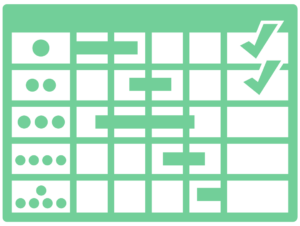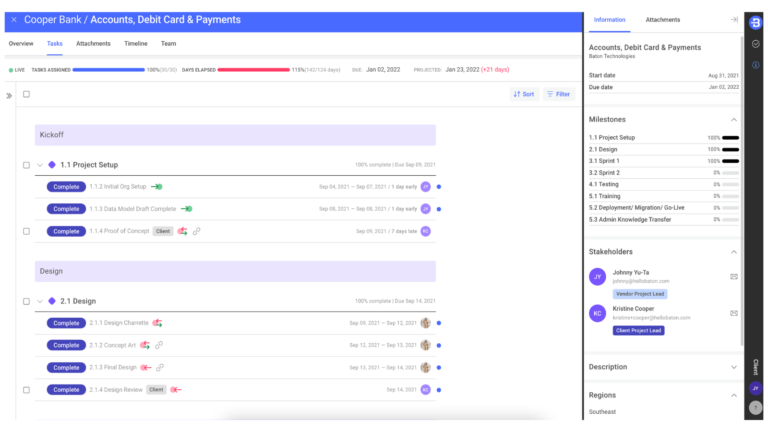Implementation is the most critical phase of the software purchase cycle, and you need to start with a plan.
There are two sides to every software implementation. The customer and the vendor. A poorly run implementation has major consequences for both.
What’s at Stake for Your Customer During Implementation
- The Problem They’re Trying to Solve – Let’s say I buy marketing automation software to give my team time back and provide more visibility into my processes. I’m three months into my contract, my team doesn’t understand the software, I spend hours a week troubleshooting, and pipeline suffers. The problem I wanted to solve is still a problem.
- Money Out, No Value In – An average of 13 cents of every dollar goes to software. Most companies don’t have the luxury of donating an eighth of their budget to shelfware.
- Time – The great promise of software as a concept is the ability to do more with less. I buy software to make my life easier. A bad implementation misses the mark on delivering value and distracts your customer from delivering value to their customer.
What’s at Stake for the Vendor During Implementation
- Failure to Launch Churn – If no one gets paid before go-live, a botched implementation has an immediate material impact.
- Lagging Retention & Pressure on New Deals – A bad onboarding is the number one reason customers churn. An onboarding problem leads to a churn problem, and your sales team has to continue to fill a leaky bucket in a down market.
- You Don’t Get Enough Usage to Improve Your Product – For smaller teams and newer products especially, usage data is the key to developing a winning product. If you add customers who churn or don’t use your product, your product team will continue to make decisions based on assumptions instead of data.
The Basics Of A Software Implementation Plan
There are three major components to any project plan; Phases, Milestones, and Tasks. Everything else included in your project plan will ultimately feed into one of these components.

Project Phases
Phases are high-level sections of an effective implementation plan. They should be divided by significant shifts in intention or responsibility. When we receive project plans from new customers, phases are oftentimes the most overlooked component. Why? Phases are the most difficult to define and can be mistaken for milestones or vice versa.
Think of it this way; your CRM is probably structured in a way that moves prospective customers through stages. Let’s say you have Lead, Opportunity, Demo, Trial, and Contracting stages before a closed won or closed lost deal. There are significantly different objectives and stakeholders associated with each of those stages.
From an implementation perspective, your first phase is kickoff. Milestones associated with that phase are pre-kickoff, requirements gathering, and kickoff. The phase is critical to structuring work in a way that clearly defines resources, objectives, and ultimately the small step your customer takes before achieving “value” from your product. Phases are sequential and signal real progress to your customer.
Let’s use a fintech implementation as an example. From kickoff, your project may move into a Core Integration phase. This will bring in new stakeholders, ICs, and a specific set of milestones. Enter a new phase.
As your organization grows and brings on different types of customers, phases may differ based on the project type. An SMB implementation requiring a more hands-off approach will have different phases than a long enterprise implementation. Phases are a key part of standardizing your process. They will give you a clearer picture, and allow you to define and measure more accurately.
Project Milestones
Milestones are a collection of related tasks needed to produce a deliverable or complete an objective. Milestones can be worked on sequentially or at the same time. Some of our customers describe milestones as “Work Packets.”
In the example of a kickoff phase, the milestones associated are pre-kickoff, requirements gathering and kickoff. The grouped tasks under those milestones directly relate to the stated objective. Under pre-kickoff, you may have a meeting with the sales team to coordinate on the problem statement from the customer (pro tip: this should probably take place before a deal closes).
Milestones show progression toward the completion of a phase. With the phase being an objective, think of the milestones as the key results that feed into them.
Finally, be sure to structure these in a way that makes sense to your team and customer. As you assign tasks, having a clear milestone associated can help individual contributors and your customer understand why they are being asked to complete a certain task.
Project Tasks
Tasks should be clearly defined, actionable activities that indicate what is being done and what the outcome is. As you build out tasks, utilize a task description cell to provide a detailed explanation of how to complete the task.
Phases and milestones should be succinct, tasks should be detailed and robust. Each task should have an individual owner, whether that’s the customer or a team member. The description should be clear for your contributor and even more clear for your customer. A collaborative project plan is key to a successful implementation, but it serves the added benefit of minimizing questions if done correctly.
Link to relevant resources or documents in the task description. If your process includes a lot of attachments, it’s worth adding a column for that. You could get creative here and link a Google Form in the cell so your customer doesn’t have to leave the project plan. If you are scoping out customer onboarding software, be sure linking and attachment functionality exists.
Collaboration is key during implementation, but it needs to be constructive. Having endless meetings about task descriptions because the project plan wasn’t clear enough doesn’t count as collaboration. Reduce the number of meetings, and increase customer engagement with robust task descriptions.
Sweat the Project Plan Details
Create a template and plan that is measurable. If you can measure it, you can improve it. Phases, Milestones and Tasks are the meat and potatoes of a software implementation plan. They are must-haves. The following points help you understand whether or not your project plan is working.
- Add Start Date and Completed Date – Self explanatory, but often overlooked. Make sure you are measuring how long each part of your plan is taking. Do this for phases, milestones and tasks.
- Estimate Each Task in Terms of Days – Measuring actuals vs. estimates will serve as a marker for your project plan efficiency. It also adds transparency for your customer. If you’re building this out in a spreadsheet, include a Difference cell that updates in real-time.
- Add in Dependencies – If task C can’t be completed until task A is, note that. Use dependencies to accurately identify which tasks are blockers. An added benefit is customer accountability. “To hold up our end of the implementation, these customer tasks need to be done.”
CRUSH EVERY SAAS IMPLEMENTATION
We offer complete project plan analysis alongside our best-in-class software implementation management solution. Schedule a demo to start a free 14-day trial.
Components That Will Accelerate Your Software Implementation Plan
If you build this out in a spreadsheet, Google Sheets, or generic project management software, you’ll get by for a while.
Customer onboarding software exists to automate and accelerate the onboarding process, and we view adopting it as an inevitability if you want a process that will keep up with your growth. The right software should include at least the following functionality, and for those getting started we have a few tips for stringing together tools until you’re ready to make the leap to dedicated onboarding software.
A Client Facing Portal
Customer engagement is paramount to a successful implementation. If it’s hard to coordinate with the customer, that’s usually a leading indicator of poor adoption and churn.
Your software implementation plan should be visible to your customer, and tasks should be clearly assigned. If you’re building this out with your existing toolset, use a shared spreadsheet that automatically updates. Sending version after version back and forth is a recipe for disaster. .

In Baton, you can show or hide specific tasks from the customer. This can help the customer focus on what’s important while leaving no stone unturned for your internal team.
Automated Status Updates and Reminders
Administrative work is a silent killer. A customer of ours put it best, “We spend less time on admin and more time driving solutions for our customers.”
Your software implementation plan should be a living, breathing document. Automatic updates provide unmatched visibility. Automated communication cleans up your email inbox, your customer’s inbox, and holds the entire project team accountable.

If your customer onboarding solution doesn’t provide this, or you are building this out in a spreadsheet, meet your customers where they are. If you are onboarding a software startup, a shared Slack may be the way to go for project updates.
Establish a Baseline Reporting, Resource Management
Measure everything you do. It may be tedious, but improving your software implementation plan is impossible without it.
In Baton, we automatically keep track of things like estimated time vs. actual, project baseline vs. actual, and time-to-launch. Track these things so you can get a better idea of where you can improve, and communicate actionable insights to your boss. For an in-depth conversation on metrics to track, check out our webcast with Jeff Kushmerek of Infinite Renewals.

As you grow, resource management will become more important. Small efficiencies add up when you run hundreds of projects a month. At Baton, we work with customers to scale their implementation process to a point where implementation can become a revenue-generating piece of their business. Tight resource management, from time tracking to budgeting, is necessary to charge for implementation.
CRUSH EVERY SAAS IMPLEMENTATION
Whether you’re just getting started or already have a dedicated team and process in place, Baton’s approach can be tailored to your specific needs and goals.



